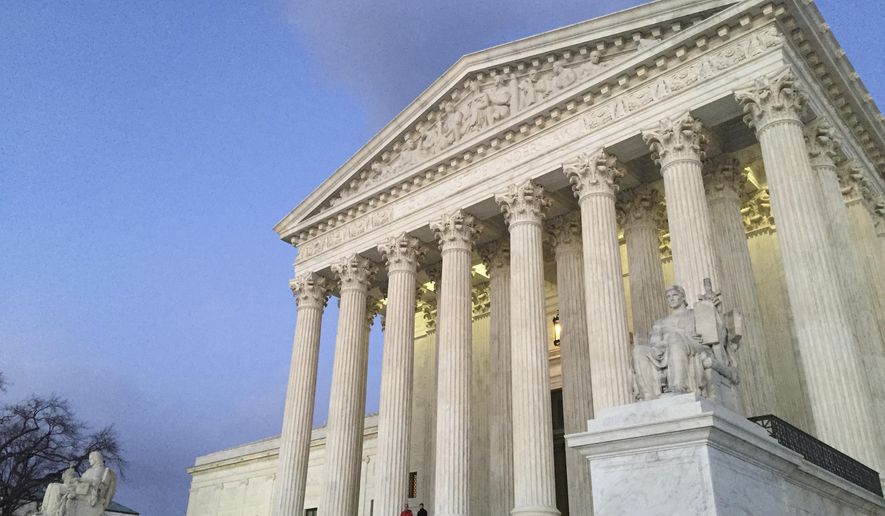WASHINGTON (AP) - Justice Anthony Kennedy appears to hold the decisive vote in two Supreme Court cases involving challenges from African-American voters to electoral districts in North Carolina and Virginia.
The court’s liberal and conservative justices seemed otherwise divided after arguments Monday about whether race played too large a role in creation of congressional districts in North Carolina and state legislative districts in Virginia.
The issue of race and redistricting one is a familiar one at the Supreme Court. States have to take race into account when drawing maps for legislative, congressional and a host of municipal political districts. At the same time, race can’t be the predominant factor, under a line of high court cases stretching back 20 years.
Kennedy said he had problems with a lower court’s reasoning in upholding 12 districts in Virginia, suggesting there could be a majority for throwing out that decision. He had less to say about the two North Carolina congressional districts, which were struck down by a lower court.
The arguments demonstrated the difficulty in distinguishing racial and partisan motivations, when African-Americans overwhelmingly vote for Democrats. The justices soon could be asked to decide whether the Constitution also prohibits electoral maps that are too partisan, in a case from Wisconsin.
Justices on both sides of the divide voiced a certain fatigue with the issue. Justice Samuel Alito suggested states are being held to an impossible standard that is “just an invitation for litigation in every one of these instances.”
Justice Stephen Breyer said he had hoped his majority opinion in a case from Alabama “would end these cases in this court, which it certainly doesn’t seem to have done.” Breyer said lawmakers could not take not a “mechanically numerical” approach to redistricting.
In Virginia, lawmakers in 2011 used the results of the 2010 census to create 12 districts in which African-Americans made up at least 55 percent of the population of eligible voters, saying that level was necessary to ensure they could elect their candidate of choice. Black voters who sued contended lawmakers packed the districts with black voters, making other districts whiter and more Republican. The effect was to dilute black voting strength, they said.
Arguing for the Virginia challengers, attorney Marc Elias said the lower court was wrong to uphold a “one size fits all” standard regardless of the different voting patterns and demographics across the 12 districts.
He drew support from Justice Elena Kagan. “It sort of defies belief you could pick a number and say that applies with respect to every majority-minority district,” Kagan said.
Paul Clement, representing Virginia, said 55 percent actually is a reasonable number for all 12 districts. “So it’s not like this number comes out of thin air,” Clement said.
Nine of the 12 districts had greater black populations under the plan in effect before the 2010 census, and two others were at least 53 percent black.
Chief Justice John Roberts, who appeared to favor the state, questioned whether it is so easy to determine the most important reason for drawing a district a particular way when there are several considerations about its geographic size and shape, as well as the interests that unite its residents. “It’s easy to imagine situations where you cannot say that one dominates over all the others.”
The North Carolina case seemed to present more of a puzzle to the court. The lower court struck down two majority-black congressional districts, finding they relied too heavily on race.
The state, also represented by Clement, conceded the use of race in one district, but only to maintain a black-majority district. In the other, Clement said, race played no role at all in the creation of one district. “This was an avowedly political draw,” he said, meaning that Republicans who controlled the redistricting process wanted to leave the district in Democratic hands, so that the surrounding districts would be safer for Republicans.
Clement also suggested that the challenges in both cases were motivated more by Democratic politics than concerns about race.
Kennedy’s votes in redistricting cases can be hard to predict. He joined Breyer’s opinion in the Alabama case last year. In 2013, Kennedy sided with more conservative justices to effectively block a key component of the landmark Voting Rights Act that led to the election of African-Americans across the South. Its provisions requiring states to create and preserve districts in which minority voting groups can elect their candidate of choice remain in effect.
In North Carolina, the federal court also struck down some state House and Senate districts, and last week, those judges ordered new districts drawn and special elections held next year.
North Carolina Republicans have used the current districts to achieve veto-proof majorities in both chambers. In addition, they hold 10 of the state’s 13 congressional seats. By contrast, statewide contests suggest a narrower gap between the parties. Two Republicans won statewide elections last month, President-elect Donald Trump with just under 50 percent of the vote and Sen. Richard Burr with 51 percent. Republican Gov. Pat McCrory on Monday conceded defeat in his closely fought bid for another term.
Decisions in Bethune-Hill v. Virginia State Board of Elections, 15-680, and McCrory v. Harris, 15-1262, are expected by early summer.




Please read our comment policy before commenting.